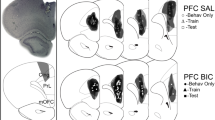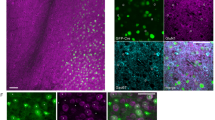Summary
Prefrontal cortex and neostriatum constituting the prefrontal system are connected by glutamatergic neurones. The involvement of this corticostriatal projection in control of maze performance of rats was investigated. Glutamatergic transmission mediated by N-methyl-D-aspartate (NMDA) receptors was blocked by intrastriatal injections of dl-2-amino-5-phosphonovaleric acid (AP-5) (50 nmole in 0.5 Μl). In experiment 1, intrastriatal AP-5 was found to increase the number of errors during acquisition of a delayed alternation task in a T-maze. In experiment 2, the effect of intrastriatal AP-5 on acquisition of different 8 arm maze tasks was investigated. AP-5 did not affect the number of reentries on spontaneous and reinforced alternation; pre- and postdelay errors on delayed alternation were not altered. Therefore, intrastriatal NMDA receptor blockade impairs acquisition of a delayed alternation in a T-maze, while intrastriatal blockade of NMDA receptors does not affect acquisition of different 8 arm maze tasks. The impairment in the T-maze task appears not to be due to deficient acquisition of spatial information per se, since 8 arm maze performance is intact. Instead, repeated delays in the T-maze task seem to be the critical component that gives difficulties in acquisition. These difficulties in bridging successive temporal discontiguities were attributed to an increased susceptibility to external and internal interfering stimuli during delays. Thus, striatal NMDA receptors within the prefrontal system may be involved in correct response retention over the duration of delays.
Similar content being viewed by others
References
Alessandri B, Welzl H, BÄttig K (1988) Effects of the non-competitive NMDA antagonist ketamine on locomotor activity and memory formation in the rat. Eur J Neurosci [Suppl]: 323
Anis SC, Berry NR, Burton NR, Lodge D (1983) The dissociative anaesthetics, ketamine and phencyclidine, selectively reduce excitation of central mammalian neurones by N-methyl-aspartate. Br J Pharmacol 79: 565–575
Becker TL, Walker JA, Olton DS, O'Conell BC (1978) Neuroanatomical bases of shortterm spatial memory in the rat. Society for Neuroscience Abstracts 4: 73
Béracochéa DJ, Jaffard R (1987) Impairment of spontaneous alternation behaviour in sequential test procedures following mamillary body lesions in mice: evidence for time dependent interference-related memory deficits. Behav Neurosci 101/2: 187–197
Bischoff C, Tiedtke PI, Schmidt WJ (1988) Learning in an 8-arm-radial-maze: effects of dopamine- and NMDA-receptor antagonists. In: Elsner N, Barth FG (eds) Sense organs. Proceedings of the 16th Göttingen Neurobiology Conference. G Thieme, Stuttgart, p 358
Bolhuis JJ, Burešová O, Bureš J (1985) Persistence of working memory in an aversively motivated radial maze task. Behav Brain Res 15: 43–49
Burešová O, Bureš J (1982) Radial maze as a tool for assessing the effect of drugs on the working memory of rats. Psychopharmacology 77: 268–271
Divac I, öberg G (1979) The neostriatum. Pergamon Press, Oxford, pp 291–313
Douglas RJ, Isaacson RI (1965) Homogeneity of simple trial response tendencies and spontaneous alternation in the T-maze. Psychol Rep 16: 87–92
Dunnet SB, Iversen SD (1981) Learning impairments following selective kainic acid-induced lesions in the neostriatum of rats. Behav Brain Res 2: 189–209
Fonnum F (1984) Glutamate: a neurotransmitter in the mammalian brain. J Neurochem 42: 1–11
Fuster JM (1981) The prefrontal cortex. Raven Press, New York, pp 41–84
Hauber W (1988) Striatal glutamate and maze performance. In: Elsner N, Barth FG (eds) Sense organs. Proceedings of th 16th Göttingen Neurobiology Conference. G Thieme, Stuttgart, p 357
Havemann U, Turski L, Schwarz M, Kuschinsky M (1983) Nigral GABAergic mechanisms and EMG activity in rats: differences between pars reticulata and pars compacta. Eur J Pharmacol 92: 49–56
Katz RJ, Schmaltz K (1981) Dopaminergic involvement in attention: a novel animal model. Prog Neuropsychopharmacol 4: 585–590
Koek W, Woods JH, Ornstein P (1987) A simple and rapid method for assessing similarities among directly observable behavioral effects of drugs: PCP-like effects of 2-amino-5-phosphonovalerate in rats. Psychopharmacology 91: 297–304
Lienert GA (1973) Verteilungsfreie Methoden in der Biostatistik, Teil I. Anton Hain, Meisenheim, S 213–216
Markowitsch HJ, Pritzel M (1977) Comparative analysis of prefrontal learning functions in rats, cats and monkeys. Psychol Bull 84/5: 817–837
Martin D, Lodge D (1985) Ketamine acts as a non-competitive N-methyl-D-aspartate antagonist on frog spinal cord in vitro. Neuropharmacology 24: 999–1003
McCann DJ, Rabin RA, Winter JC (1987) Use of the radial maze in studies of phencyclidine and other drugs of abuse. Physiol Behav 40/6: 805–812
Monaghan DT, Cotman CW (1985) Distribution of N-methyl-D-aspartate-sensitive L-(3H)glutamate-binding sites in rat brain. J Neurosci 11: 2909–2919
Montgomery KC (1954) The role of the exploratory drive in learning. J Comp Physiol Psychol 47: 60–64
Morris RGM, Anderson E, Lynch GS, Baudry M (1986) Selective impairment of learning and blockade of long-term-potentiation by a N-methyl-D-aspartate receptor antagonist, AP-5. Nature 319: 774–776
Nieuwenhuys P (1985) Chemocytoarchitecture of the brain. Springer, Berlin Heidelberg New York, pp 48–51
Olton DS, Becker JT, Handelmann GE (1979) Hippocampus, space and memory. Behav Brain Sci 2: 313–366
Olton DS, Samuelson RJ (1976) Remembrance of places passed: spatial memory in rats. J Exp Psychol [Anim Behav] 2: 97–116
Olvermann HJ, Jones AW, Watkins JC (1984) L-Glutamate has higher affinity than other amino acids for (3H)-D-AP-5 binding sites in rat brain membranes. Nature 307: 460–462
Paxinos G, Watson C (1982) The rat brain in stereotaxic coordinates. Academic Press, Sydney
Pisa M (1983) Kainic acid injections into the rat neostriatum: effects on learning and exploration. In: Fuxe K, Roberts R, Schwarcz R (eds) Excitotoxins. Wenner-Gren Int Symp, vol 39. Macmillan, London
Rosvold HE (1968) The prefrontal cortex and caudate nucleus: a system for effecting correction in response mechanisms. In: Rupp E (ed) Mind as a tissue. Harper and Row, New York, pp 21–38
Ryan CN, Dunnett SB, Scheel-Krüger J (1988) Damage to the prefrontal cortex impairs spatial navigation learning but not the acquisition of spatial knowledge. Psychopharmacology 96/1: p 48
Sandberg M, Ward HK, Bradford HF (1985) Effects of cortico-striate pathway lesion on the activities of enzymes involved in synthesis and metabolism of amino acid neurotransmitters in the striatum. J Neurochem 44: 42–44
Simon H, Le Moal M (1984) Mesencephalic dopaminergic neurons; functional role. In: Catecholamines: neuropharmacology and central nervous system. Theoretical aspects. Alan R Liss, New York, pp 293–307
Scheel-Krüger J, Vrijmoed-De Vries MC (1986) Distinct functional effects of glutamic acid and dopamine within various regions of the striatum. Neurosci Lett [Suppl] 26: p 27
Schmidt WJ (1986) Intrastriatal injection of dl-2-amino-5-phosphonovaleric acid (AP-5) induces sniffing that is antagonized by haloperidol and clozapine. Psychopharmacology 90: 123–130
Schmidt WJ, Bury D (1988) Behavioural functions of N-methyl-D-aspartate (NMDA) in the antero-dorsal striatum of the rat. Life Sci 43/6: 545–549
Schmidt WJ, Bubser M (1987) 6-Hydroxydopamine lesions of the prefrontal cortex reduce stereotypy and enhance catalepsy. In: Elsner N, Creutzfeldt O (eds) New frontiers in brain research. Proc. 15th Göttingen Neurobiology Conference. G Thieme, Stuttgart, p 278
Turski L (1988) Muscle relaxant action of excitatory amino acid antagonists: sites of action. Neurochem Int 12 [Suppl 1]: 11
Turski WA, Sonntag KH (1988) Basal ganglia and motor control in the rat: effect of intrastriatal and intrapallidal 2-amino-7-phosphonoheptanoate on motility. Neurochem Int 12 [Suppl 1]: p 35
Walaas I (1981) Biochemical evidence for overlapping neocortical and allocortical projections to the nucleus accumbens and rostral caudatoputamen in the rat brain. Neuroscience 6: 399–405
Wikmark RGE, Divac I, Weiss R (1973) Retention of spatial delayed alternation in rats with lesions in the frontal lobes. Brain Behav Evol 8: 329–339
Author information
Authors and Affiliations
Rights and permissions
About this article
Cite this article
Hauber, W., Schmidt, W.J. Effects of intrastriatal blockade of glutamatergic transmission on the acquisition of T-maze and radial maze tasks. J. Neural Transmission 78, 29–41 (1989). https://doi.org/10.1007/BF01247111
Received:
Accepted:
Issue Date:
DOI: https://doi.org/10.1007/BF01247111




